Ghana is home to an incredible array of birds. Over 850 species of birds have been recorded in the country, making it one of the most impressive bird-watching destinations in Africa.
From the spectacular woodland birds of the savannah to the dazzlingly colorful birds of the rainforest, Ghana has something for everyone. From the stately crowned cranes to the diminutive sunbirds, the birds of Ghana will amaze and delight the casual observer and the avid birder alike.
1. White-Necked Rockfowl
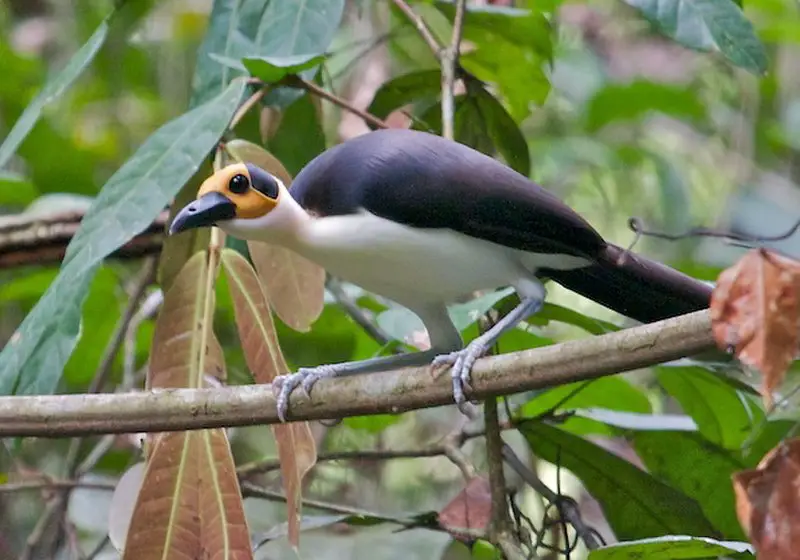
The white-necked rockfowl is a medium-sized bird found in West Africa from Guinea to Ghana. It has a distinctive long neck and tail, as well as predominantly grey feathers with contrasting black wings and beady eyes.
This passerine enjoys rocky forested areas at higher altitudes, but its distribution can be patchy due to isolation of populations from each other.
Its call is unique too; the rockfowl will often “choo” or make soft clucking noises when excited or frustrated.
These birds are quite shy and solitary by nature so it may take some patience to observe them in their natural environment.
Scientific classification:
| Kingdom | Animalia |
| Phylum | Chordata |
| Class | Aves |
| Order | Passeriformes |
| Family | Picathartidae |
| Genus | Picathartes |
| Species | P. gymnocephalus |
Also Featured In: African Rainforest Birds,
2. Standard-Winged Nightjar
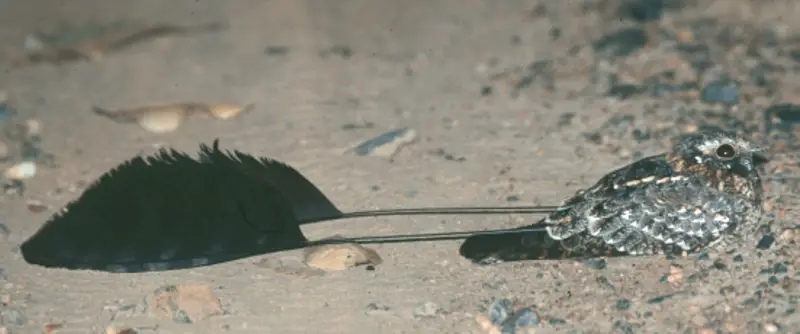
The Standard-winged nightjar is a nocturnal bird belonging to the nightjar family. It can be found in dry savannah habitats and some scrub across Africa, from Senegal east to Ethiopia.
During breeding season, adult males have an unusual wing ornament consisting of a broad central flight feather on each wing that elongates up to 38 centimetres (15 inches).
They also boast distinctive black throats with white spots which contrast against their brown and grey plumage.
The wings’ undersides are marked by two whitish bars while white patches at the base of its tail add further detail when in flight. In addition, they possess large eyes adapted for hunting food such as insects during twilight hours whilst keeping still and silent like other members of this secretive species.
Scientific classification:
| Kingdom | Animalia |
| Phylum | Chordata |
| Class | Aves |
| Order | Caprimulgiformes |
| Family | Caprimulgidae |
| Genus | Caprimulgus |
| Species | C. longipennis |
3. Abyssinian Roller
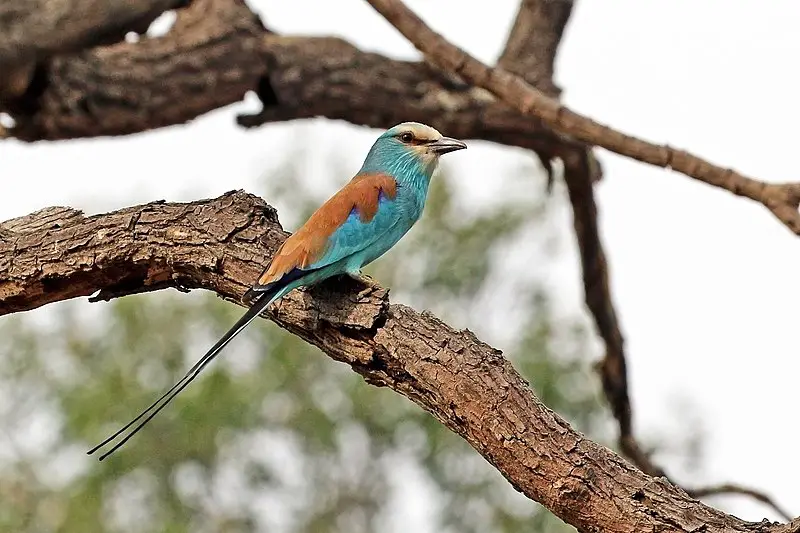
The Abyssinian roller is a large bird, nearly 28 cm in length. It has an unmistakable plumage of bright blue upperparts with chestnut underparts and wings.
Its head is blackish-blue and its tail feathers are white tipped giving it a striking appearance when seen in flight.
This species breeds across tropical Africa from the Sahel belt south of the Sahara desert to East Africa.
Northern populations tend to migrate short distances after wet season while southern ones stay resident throughout year.
They feed mainly on insects which they catch by hovering over fields or open woodland before diving down onto their prey below them.
In addition, they also eat small reptiles, amphibians and rodents along with fruits such as figs occasionally too.
Scientific classification:
| Kingdom | Animalia |
| Phylum | Chordata |
| Class | Aves |
| Order | Coraciiformes |
| Family | Coraciidae |
| Genus | Coracias |
| Species | C. abyssinicus |
4. African Pied Hornbill
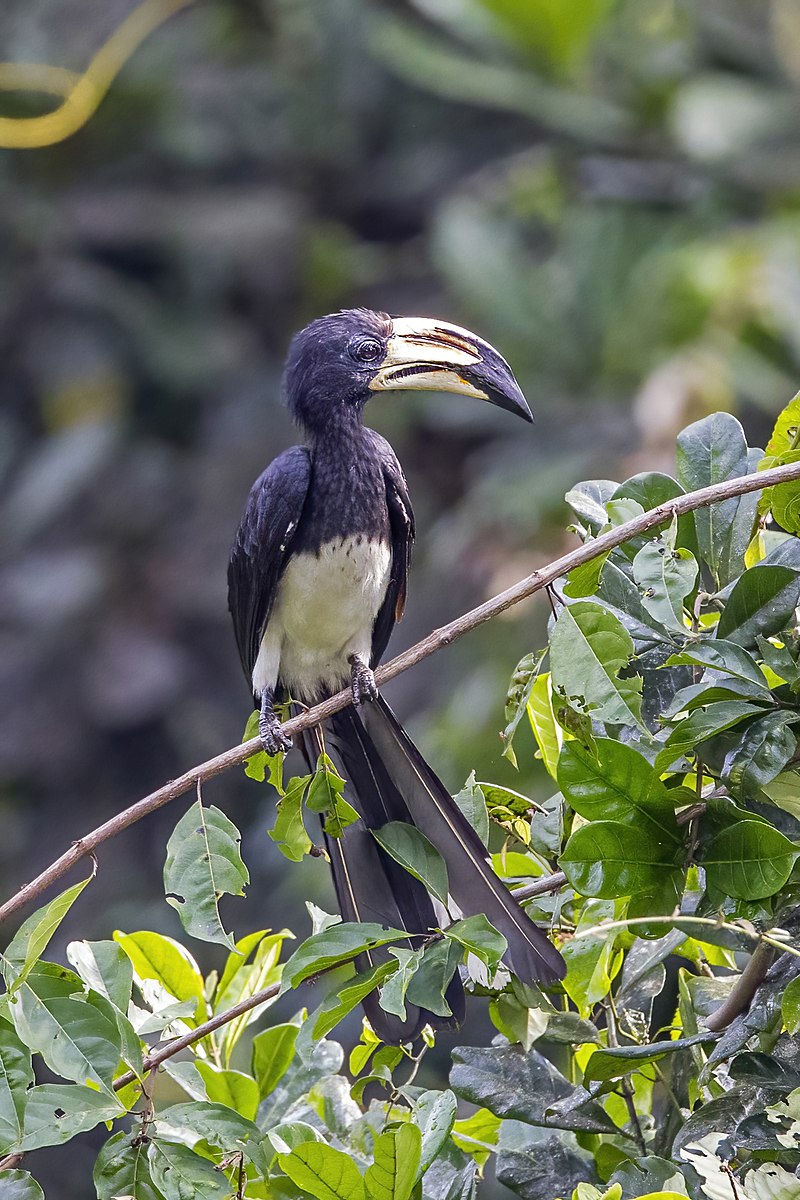
The African pied hornbill is a beautiful bird belonging to the family of tropical near-passerine birds found in the Old World.
It is widely distributed across equatorial Africa, ranging from The Gambia to western Uganda and northern Angola.
This species prefers habitats with plenty of trees for it to nestle in and make its home.
When breeding season arrives, females lay up to four white eggs inside tree holes that are sealed off by the males using mud or other materials as part of their nesting ritual.
These magnificent creatures have distinctive features such as black feathers on their bodies contrasted against bright yellow eyes and strikingly long beaks which they use mainly for eating fruit but also insects too.
They are an important part of African ecosystems and should be protected at all costs so future generations can continue appreciating these majestic birds.
Scientific classification:
| Kingdom | Animalia |
| Phylum | Chordata |
| Class | Aves |
| Order | Bucerotiformes |
| Family | Bucerotidae |
| Genus | Lophoceros |
| Species | L. fasciatus |
5. White-Throated Bee-Eater
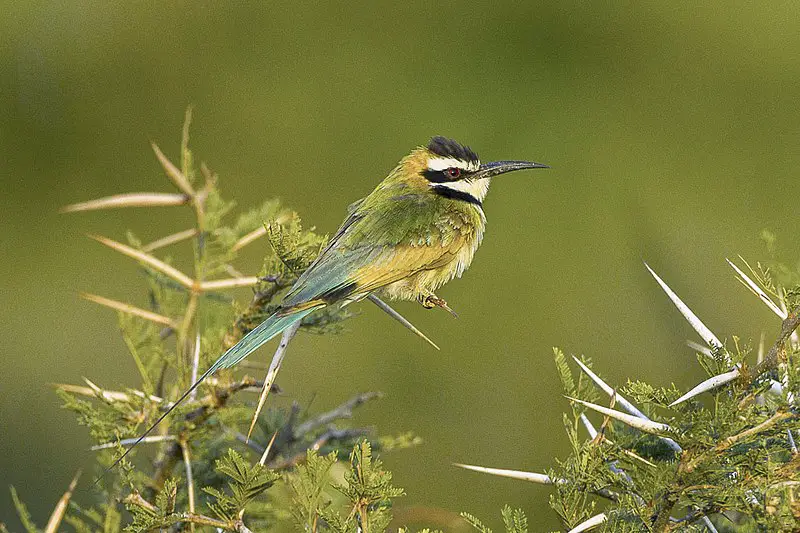
The White-throated bee-eater is a stunningly colourful bird that belongs to the Meropidae family in the near passerine category.
It breeds in semi-desert regions along southern Sahara and migrates during winter months to equatorial rain forests from Senegal to Uganda, where it enjoys different habitat experiences.
Its plumage consists of bright blues, greens and yellows with a distinctive white throat patch which gives it its name.
They feed on insects such as bees, dragonflies and wasps by catching them mid flight or plucking them off vegetation before returning back to their perch spot for eating; they perform aerial acrobatics while hunting.
These birds are social creatures who form colonies when breeding season arrives around springtime.
Their nests consist of tunnels dug up into sandy banks or termite mounds lined with grasses providing protection against predators like snakes and monitor lizards making this species an excellent example of adaptation in nature.
Scientific classification:
| Kingdom | Animalia |
| Phylum | Chordata |
| Class | Aves |
| Order | Coraciiformes |
| Family | Meropidae |
| Genus | Merops |
| Species | M. albicollis |
Also Featured In: Common Algerian Birds , Chad Birds You Didn’t Know
6. Black-Casqued Hornbill
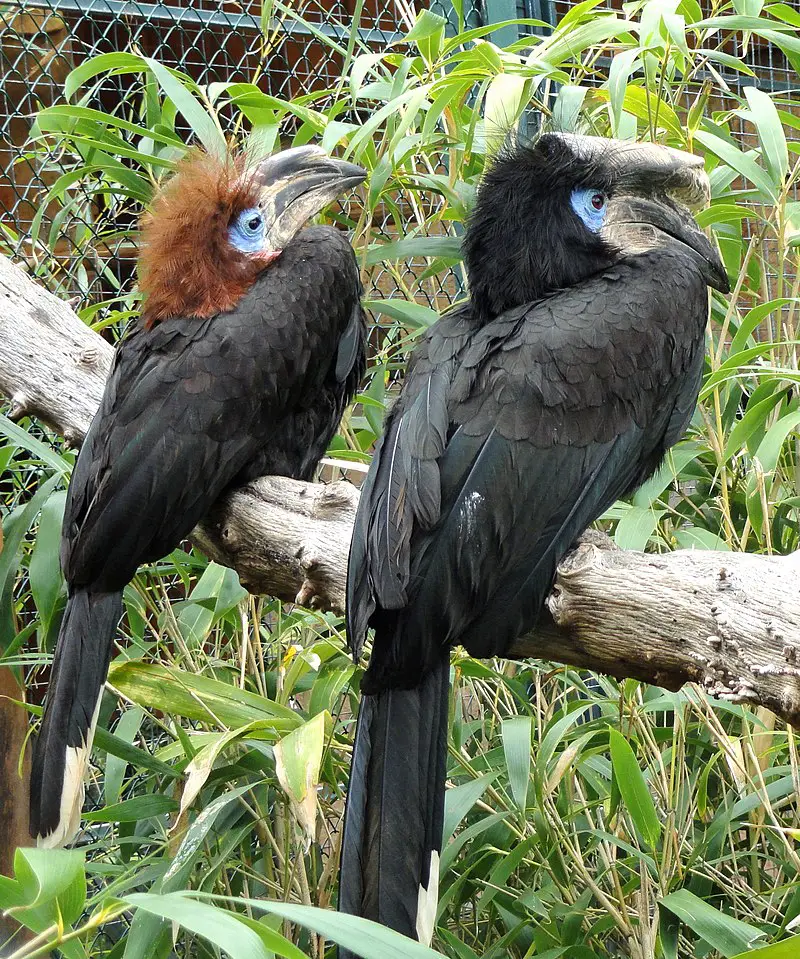
The black-casqued hornbill is a species of bird in the Bucerotidae family, often found across African tropical rainforest.
It has distinctive black casques on its beak and wattles on its throat which gives it an eye-catching appearance.
As with all Hornbills, they have large bills and strong legs for flying long distances to find food – usually insects such as beetles or caterpillars.
They also enjoy eating fruit when they can find them.
The Black-Casqued Wattled Hornbill typically lives alone but during mating season will form small groups consisting of two females and one male; these birds are monogamous so the same couple stay together throughout their life cycle.
Scientific classification:
| Kingdom | Animalia |
| Phylum | Chordata |
| Class | Aves |
| Order | Bucerotiformes |
| Family | Bucerotidae |
| Genus | Ceratogymna |
| Species | C. atrata |
7. African Piculet
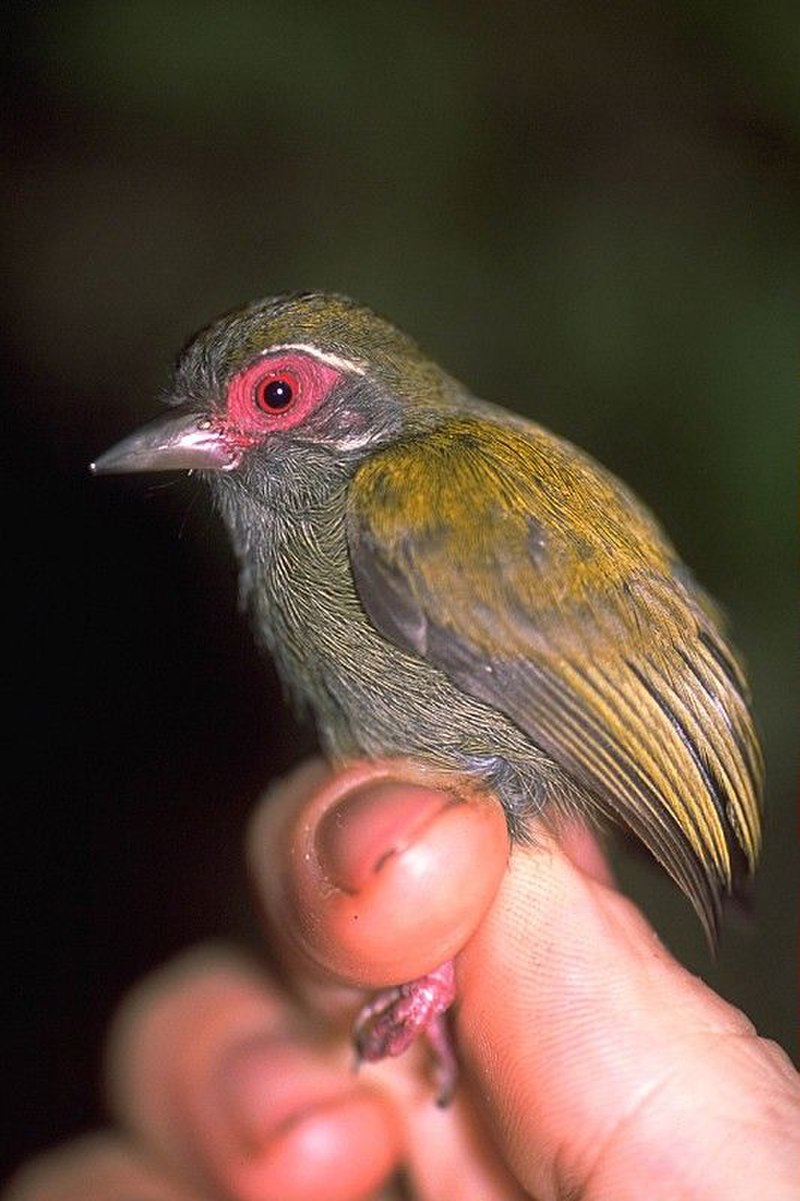
The African Piculet is a small species of bird that belongs to the family Picidae. It can be found in Angola, Cameroon, Central African Republic, Republic of Congo, Democratic Republic of Congo, Ivory Coast, Equatorial Guinea and many other countries across Africa.
This species is locally common and has a very large range which makes it quite unique among birds. They have mostly olive-brown plumage with yellowish underparts and white streaks on their wings as well as black patches near their tails.
The males usually have brighter plummage than females while both sexes are similar overall in size.
These piculets feed mainly on insects but may consume some berries or fruits when available too. Their call consists of short notes such as ‘chips’ or ‘cheeps’ which they use to communicate between each other while searching for food during winter times.
Scientific classification:
| Kingdom | Animalia |
| Phylum | Chordata |
| Class | Aves |
| Order | Piciformes |
| Family | Picidae |
| Genus | Sasia |
| Species | S. africana |
8. White-Breasted Guineafowl
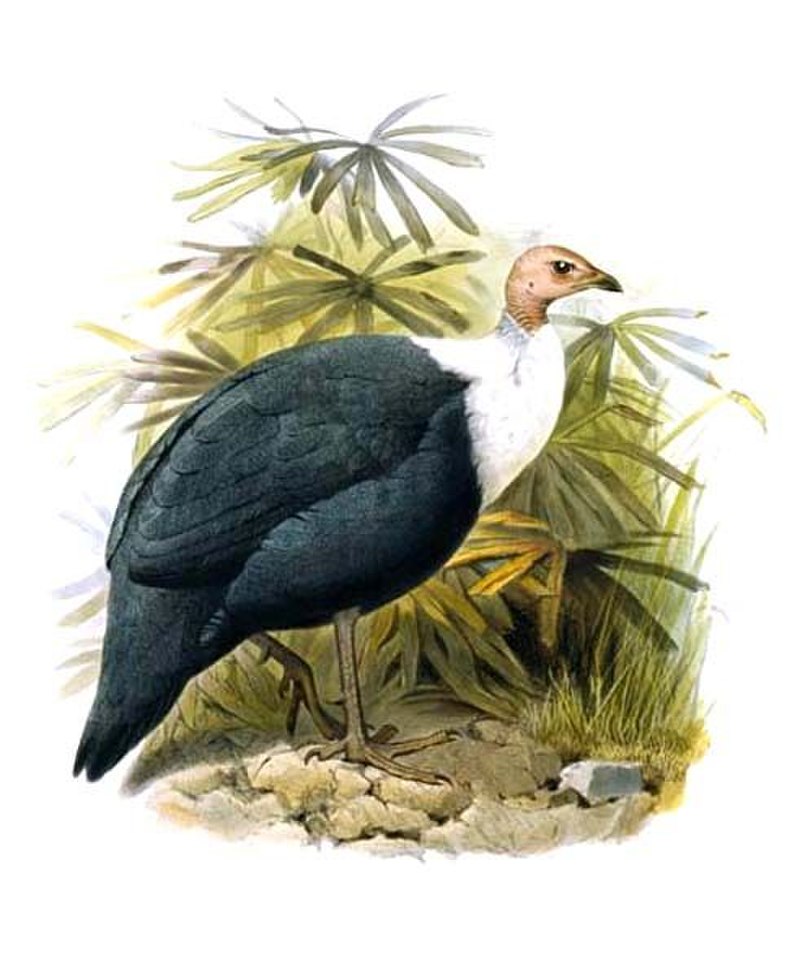
The White-breasted Guineafowl is a medium sized bird of the guineafowl family, growing up to 45 cm long. It has a black plumage with a small, bare red head and white breast.
Its tail is long and black while its bill and feet are greenish-brown in coloration. The sexes look similar although females tend to be slightly smaller than males.
This species can be found in subtropical West Africa where it prefers open forests or grassy savannas as well as agricultural lands near villages for food sources such as insects, seeds and berries which make up their diet.
They also feed on invertebrates such as snails, worms and frogs when available. Breeding season occurs from April through May during rainy weather when nesting sites are abundant with vegetation cover providing protection from predators for their eggs until hatching time arrives around 4 weeks later.
Scientific classification:
| Kingdom | Animalia |
| Phylum | Chordata |
| Class | Aves |
| Order | Galliformes |
| Family | Numididae |
| Genus | Agelastes |
| Species | A. meleagrides |
9. Piping Hornbill
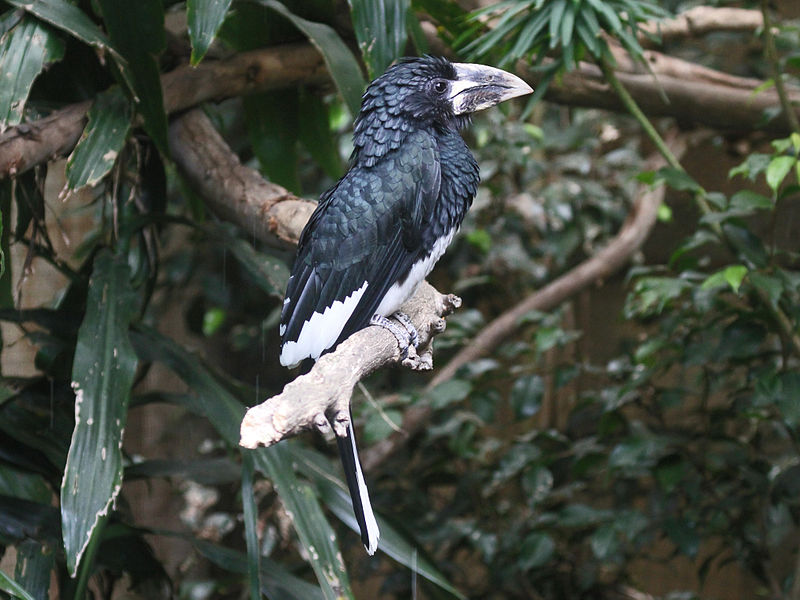
The Piping Hornbill is a small bird with black and white feathers that lives in humid forests and second growth areas from Senegal east to Uganda, south to Angola.
It’s the smallest member of its genus Bycanistes measuring only 50 cm in length. This species is quite skittish but can be seen perched on branches or flying around looking for food during daylight hours.
Its diet consists mainly of insects such as grasshoppers, beetles, caterpillars, termites and ants which it catches by using its long bill like a pair of chopsticks. They also consume ripe fruits when they come across them while out hunting.
These birds play an important role within their habitat since they help disperse seeds through their droppings which helps increase biodiversity throughout Africa’s tropical rainforests.
Scientific classification:
| Kingdom | Animalia |
| Phylum | Chordata |
| Class | Aves |
| Order | Bucerotiformes |
| Family | Bucerotidae |
| Genus | Bycanistes |
| Species | B. fistulator |
10. Senegal Coucal
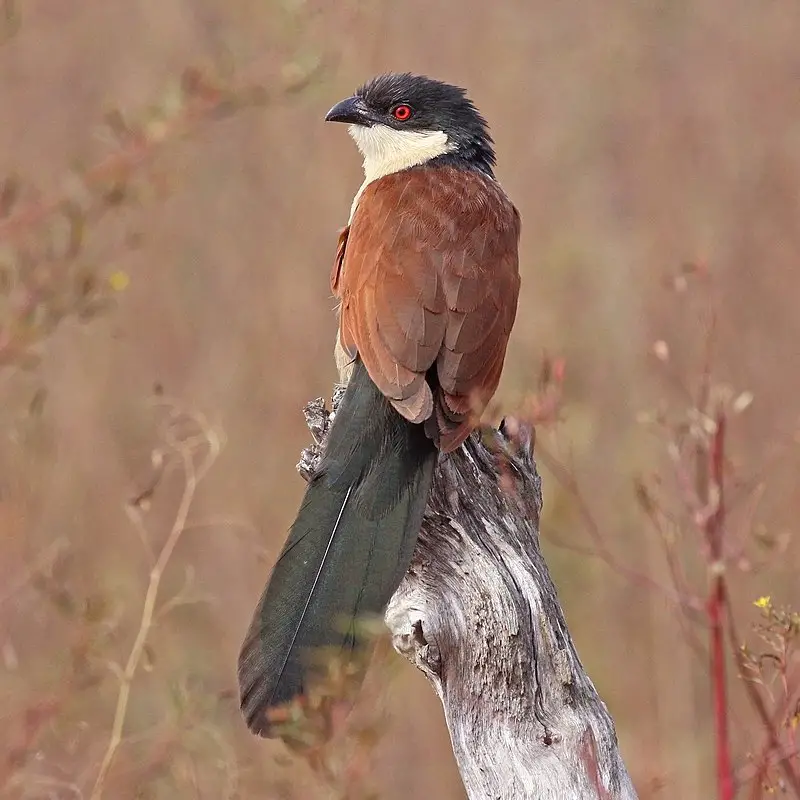
The Senegal coucal is a cuckoo-like bird native to Central and Southern Africa. It has a medium-sized body with black wings, tail and head along with white breast feathers.
Its natural habitat consists of lightly wooded savannahs where it feeds on insects, small reptiles, amphibians and fruits.
This species can be found in pairs or alone atop low bushes searching for prey or perched up high singing its distinctive song that features a mix of harsh notes as well as melodic ones.
The Senegal coucal enjoys the sun’s rays but also loves sheltering in dense vegetation when danger arises nearby.
Overall this beautiful bird makes an interesting addition to any backyard garden.
Scientific classification:
| Kingdom | Animalia |
| Phylum | Chordata |
| Class | Aves |
| Order | Cuculiformes |
| Family | Cuculidae |
| Genus | Centropus |
| Species | C. senegalensis |
11. Woodland Kingfisher
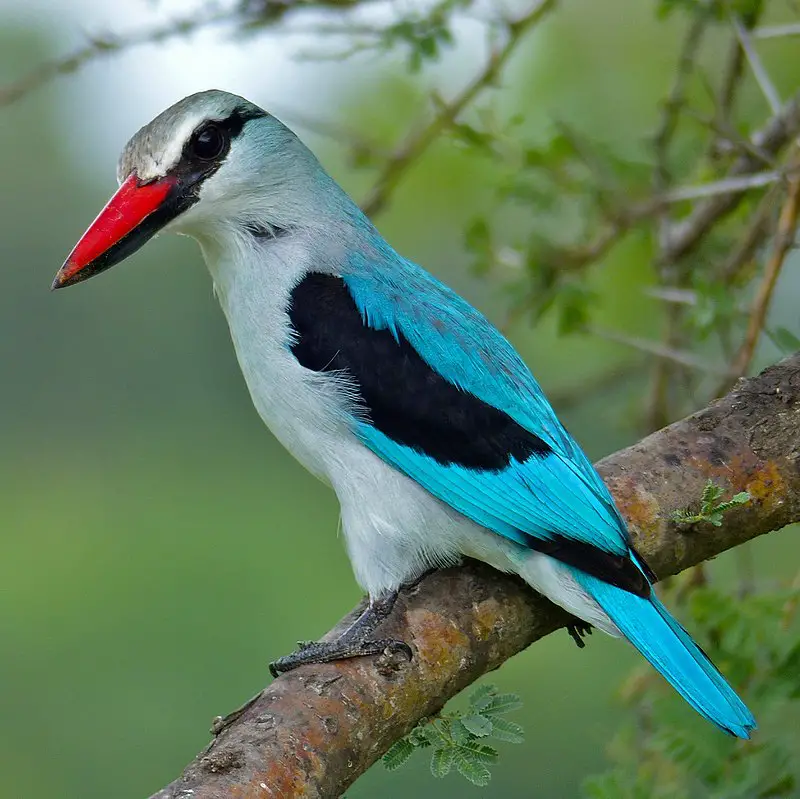
The Woodland Kingfisher is a beautiful bird, native to Africa south of the Sahara. It was first described in 1766 by Carl Linnaeus who called it Alcedo senegalensis.
This tree kingfisher has an attractive blue and white plumage with some red and black markings on its wings, tail and head.
The male also has a bright orange beak which helps to distinguish him from the female whose beak is yellowish-green.
These birds can usually be found in wooded areas near water sources such as rivers or lakes where they hunt for food including fish, frogs, small insects and even lizards.
They build their nests either high up in trees or inside holes dug out of banks near rivers and ponds.
Although not threatened yet, these lovely creatures need our protection so that future generations will have the chance to marvel at them too.
Scientific classification:
| Kingdom | Animalia |
| Phylum | Chordata |
| Class | Aves |
| Order | Coraciiformes |
| Family | Alcedinidae |
| Subfamily | Halcyoninae |
| Genus | Halcyon |
| Species | H. senegalensis |
12. Senegal Thick-Knee
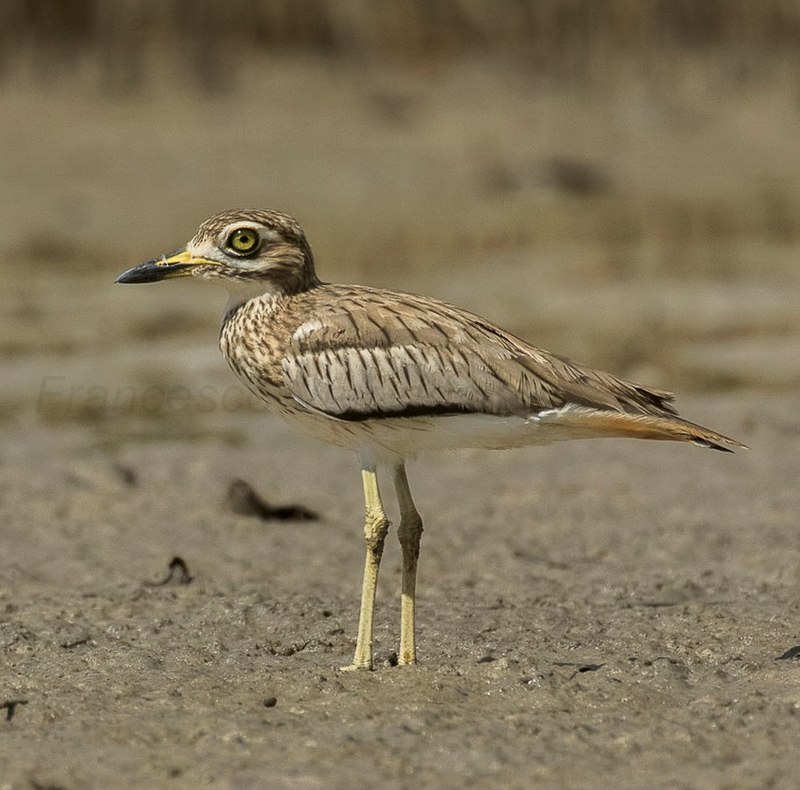
The Senegal Thick-Knee is a large wading bird found in Africa. It has long yellow or greenish legs with prominent joints and black and yellow beak. This species breeds between the Sahara Desert to the equator, as well as in the Nile Valley, making it one of Africa’s most wide spread birds.
They are solitary creatures but can often be seen perching on fences or trees looking out for prey such as insects and small rodents which they hunt using their strong bills.
The Senegal thick-knee also feeds on carrion, scavenging food from other animal sources when available. During breeding season these birds become more vocal, producing loud calls that can travel across miles of open terrain so they can attract mates and establish territories.
Overall this unique African resident provides an important link in its local ecosystem by providing both food resources for predators while keeping insect populations under control through hunting activities.
Scientific classification:
| Kingdom | Animalia |
| Phylum | Chordata |
| Class | Aves |
| Order | Charadriiformes |
| Family | Burhinidae |
| Genus | Burhinus |
| Species | B. senegalensis |
13. Blue-Bellied Roller
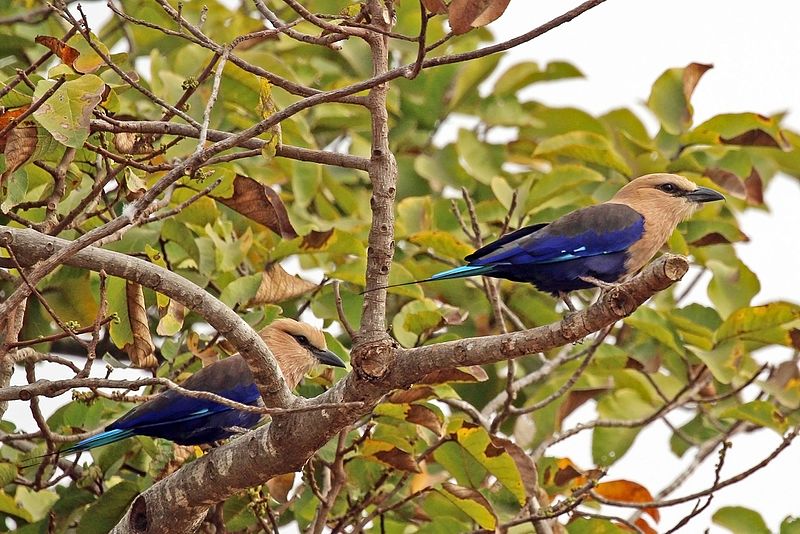
The Blue-bellied Roller is a stunning bird native to Africa. It has beautiful blue wings and underside, contrasting with its otherwise brown feathers.
This species of roller typically resides in moist savannahs dominated by Isoberlinia trees where there is an abundance of mature vegetation for them to feed on.
Its range stretches from Senegal all the way up to northeast Democratic Republic Congo, although it may migrate seasonally within this area.
The first description and binomial name Coracias cyanogaster was given by Fre in 1816; since then they have remained largely unchanged as they are well adapted to their environment.
Scientific classification:
| Kingdom | Animalia |
| Phylum | Chordata |
| Class | Aves |
| Order | Coraciiformes |
| Family | Coraciidae |
| Genus | Coracias |
| Species | C. cyanogaster |
14. Grasshopper Buzzard
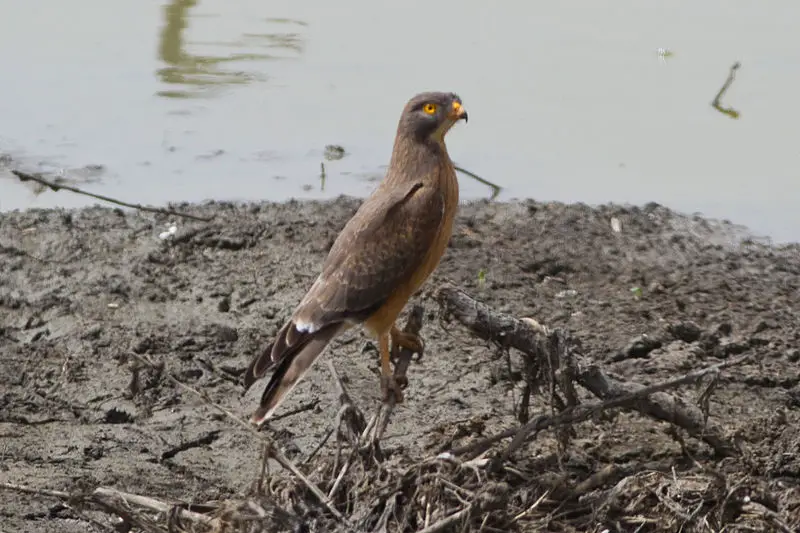
The Grasshopper Buzzard is a species of bird of prey found in sub-Saharan Africa north of the equator. It forms a superspecies with three other buzzards, all from Asia: White-eyed Buzzard, Rufous-winged Buzzard and Grey-faced Buzzard.
The adult has grey upperparts and white underparts with black streaks on its chest. Its head is dark brownish grey while its tail is pale buff barred with dark brown bands.
This medium sized raptor typically hunts grasshoppers or small rodents from a perch but may also soar high to search for prey using their keen eyesight over open country or forest edges.
They are mainly monogamous birds nesting on large trees at the edge of woodlands where they lay up to three eggs which hatch after an incubation period lasting between 28 – 32 days long by both parents taking turns feeding them food items such as frogs, lizards and insects until fledging almost six weeks later when they leave the nest independently before fully matured into adulthood when they reach two years old.
Scientific classification:
| Kingdom | Animalia |
| Phylum | Chordata |
| Class | Aves |
| Order | Accipitriformes |
| Family | Accipitridae |
| Genus | Butastur |
| Species | B. rufipennis |
15. Red-Throated Bee-Eater
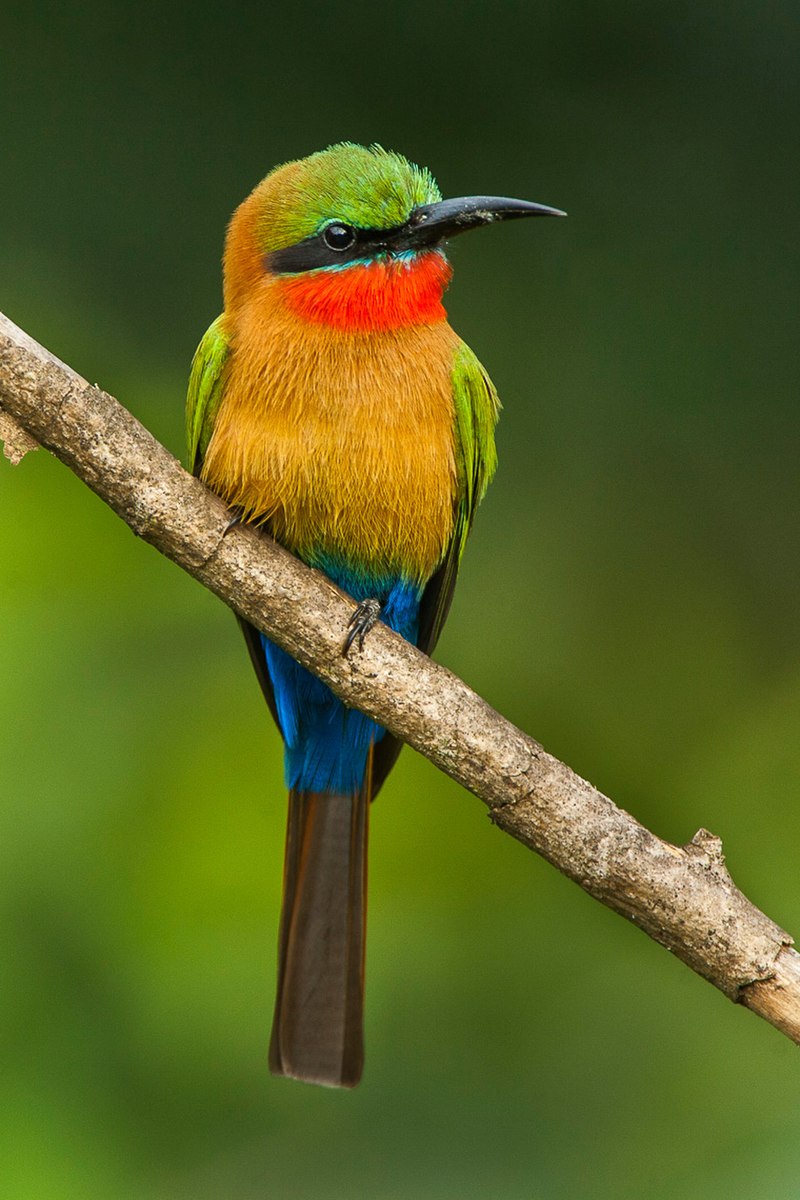
The Red-throated Bee-eater is a beautiful species of bird found in tropical Africa. It has bright red feathers covering its throat, giving it a distinct look.
Its body is mostly brown with white stripes and its wings are dark blue on the tips.
This species enjoys an extensive range throughout countries like Benin, Burkina Faso, and Togo to name just a few.
These birds feed mainly on insects that they catch in midair or from nearby foliage during their hunting flights over open country habitats such as woodlands and savannas.
While not much else is known about this particular type of bee-eater, these colorful creatures have surely become quite popular due to their striking beauty.
Scientific classification:
| Kingdom | Animalia |
| Phylum | Chordata |
| Class | Aves |
| Order | Coraciiformes |
| Family | Meropidae |
| Genus | Merops |
| Species | M. bulocki |
16. Western Wattled Cuckooshrike
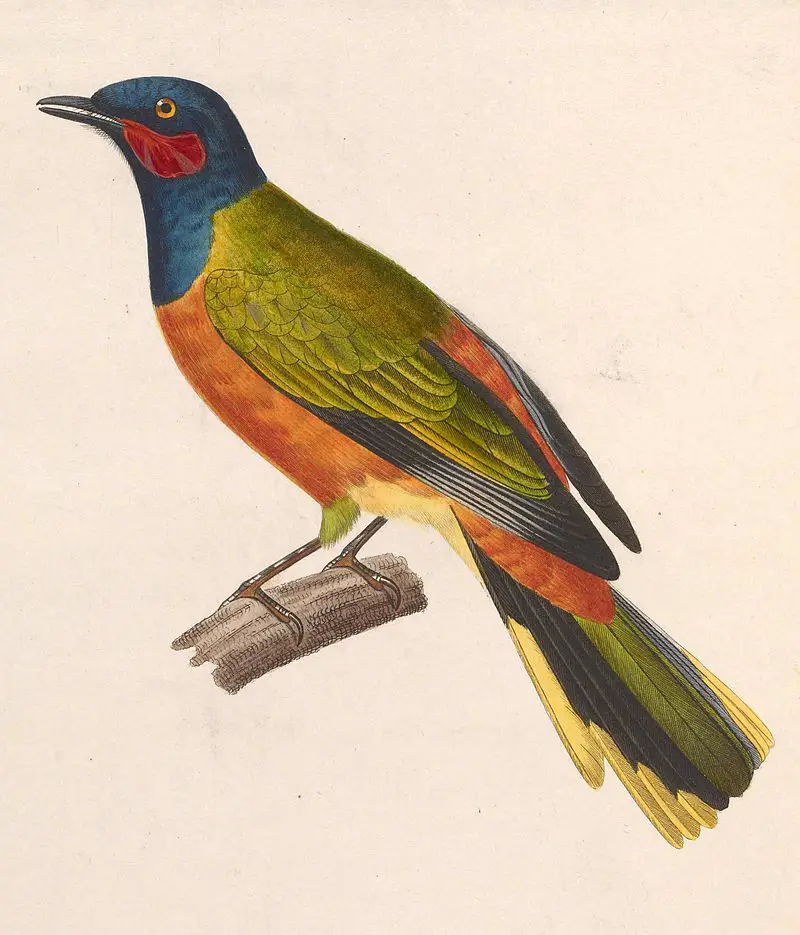
The Western wattled cuckooshrike, also known as the Ghana cuckooshrike, is a bird native to western Africa. It can be found in Ivory Coast, Ghana, Guinea, Liberia and Sierra Leone living primarily in subtropical or tropical moist lowland forests and swamps.
Unfortunately this species is threatened by habitat loss due to human activities such as deforestation for agriculture and timber production.
This beautiful bird has an average length of about 17 cm with grey-brown feathers on its upperparts while their underparts are whitish yellow which contrast attractively against their dark wings that have white spots along them.
These birds form pairs during mating season when they build nests together out of twigs lined with soft material like mosses or grasses typically high up in trees near water bodies where they feed mainly on insects such as caterpillars and beetles but may also eat fruits occasionally.
Scientific classification:
| Kingdom | Animalia |
| Phylum | Chordata |
| Class | Aves |
| Order | Passeriformes |
| Family | Campephagidae |
| Genus | Lobotos |
| Species | L. lobatus |
17. Black Bee-Eater
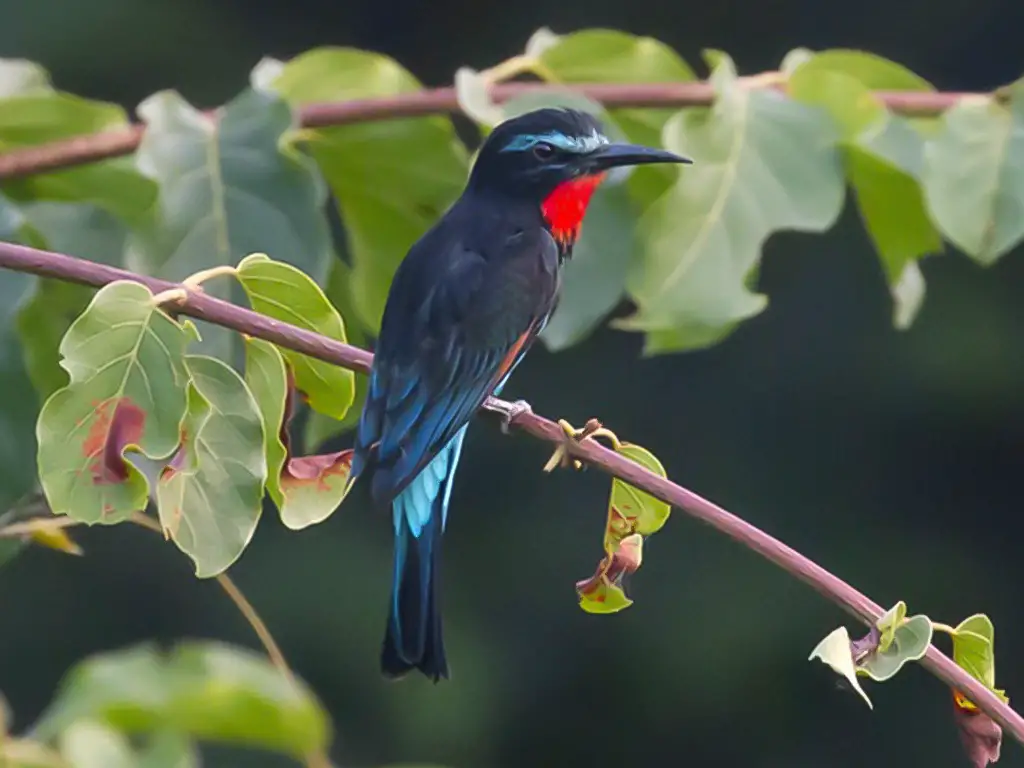
The Black bee-eater is an impressive bird that loves to live in the African tropical rainforest. It has a length of around 20 cm and its predominantly black body features some striking colors such as scarlet chin, throat, blue eyebrow, belly and undertail-coverts.
This beautiful creature also enjoys frequenting secondary woodland at the edges of its natural habitat. Its diet mainly consists of bees which it hunts by flying close to them or perching on branches waiting for prey to pass nearby.
During breeding season they construct their nests inside sandy banks where they lay 2–3 eggs each year while both parents take turns incubating them until they hatch and care for their young ones afterwards.
Although not endangered yet this species still needs our protection so we can all enjoy these incredible birds.
Scientific classification:
| Kingdom | Animalia |
| Phylum | Chordata |
| Class | Aves |
| Order | Coraciiformes |
| Family | Meropidae |
| Genus | Merops |
| Species | M. gularis |
18. Black Dwarf Hornbill
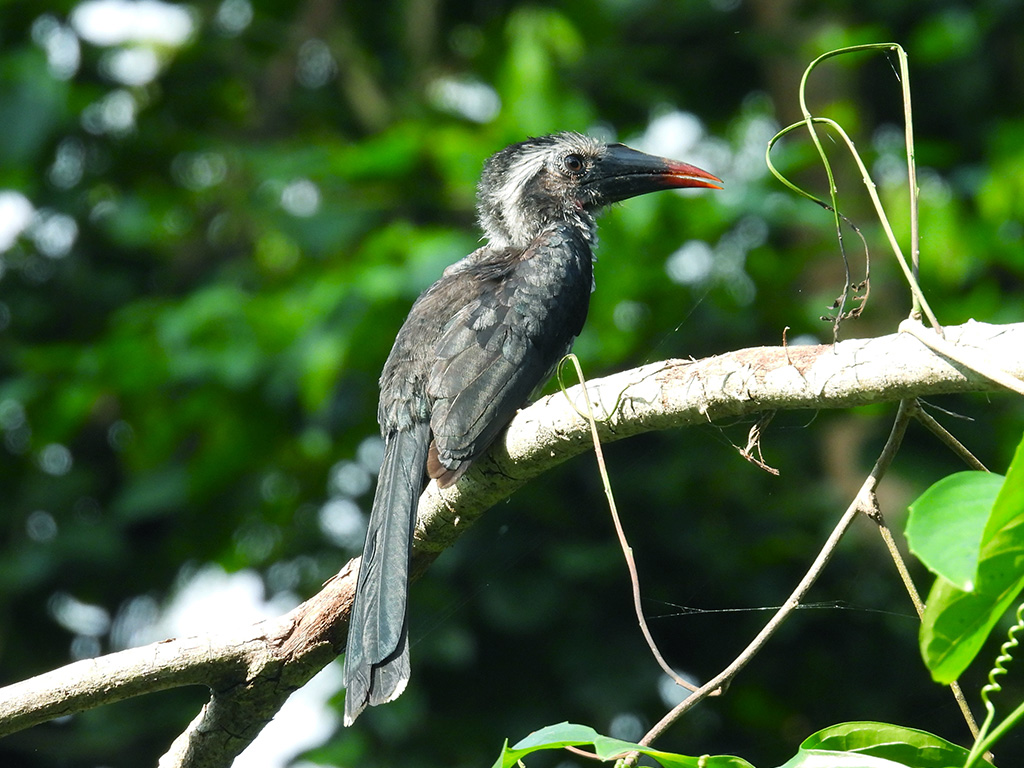
The black dwarf hornbill, also known as the western little hornbill, is an impressive species of bird found in African tropical rainforests. It has a striking appearance with its glossy black feathers and wide white brow above its eye that contrasts sharply against it’s curved beak.
The wingspan can reach up to 30 cm long and they have strong legs which enable them to perch on branches for extended periods of time while searching for food such as insects or small fruits.
They are usually solitary birds but during breeding season pairs will form monogamous relationships until the young hatchlings fledge after approximately 3 months.
These beautiful birds play a vital role within their ecosystem by dispersing seeds throughout the forest floor helping promote biodiversity in forests across Africa.
Scientific classification:
| Kingdom | Animalia |
| Phylum | Chordata |
| Class | Aves |
| Order | Bucerotiformes |
| Family | Bucerotidae |
| Genus | Horizocerus |
| Species | H. hartlaubi |
19. Brown-Cheeked Hornbill
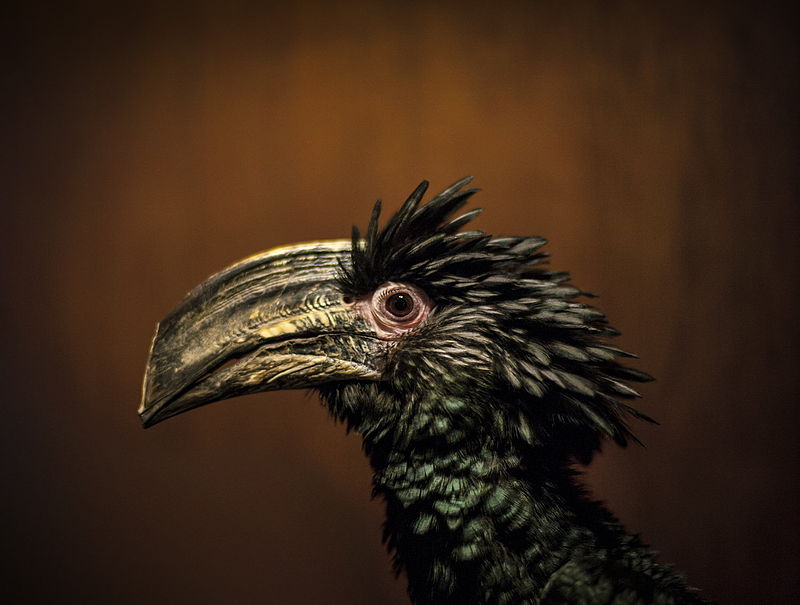
The Brown-Cheeked Hornbill is a species of bird from the Bucerotidae family, native to West Africa and found in countries such as Ivory Coast, Ghana, Guinea, Liberia and Sierra Leone.
It prefers to inhabit tropical or subtropical moist forests and plantations with secondary growths.
Unfortunately its populations are declining due to habitat destruction caused by human activities such as timber harvesting.
This beautiful bird has brown feathers on its body while it’s head feathers are black with yellow stripes running down either side at the top of their heads towards the eyes which have blue skin around them.
The males also feature an orange bill while females lack this trait completely instead having a dark grey one.
Despite being threatened they remain quite common across their range however conservation efforts must be undertaken if we wish for these birds continue living happily for many more years.
Scientific classification:
| Kingdom | Animalia |
| Phylum | Chordata |
| Class | Aves |
| Order | Bucerotiformes |
| Family | Bucerotidae |
| Genus | Bycanistes |
| Species | B. cylindricus |
Also Featured In: Birds of Côte d’Ivoire,
20. White-Bibbed Swallow
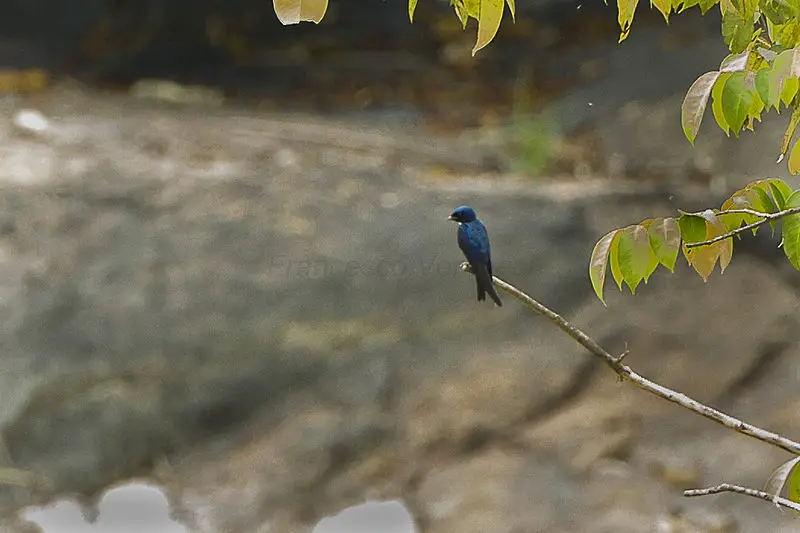
The White-bibbed Swallow is a species of bird found in Central and West Africa. They have an unmistakable appearance, featuring white bibs on their chests that contrast with the blue coloring of their feathers, as well as white throats.
Their diet consists mainly of insects which they catch mid-air while flying.
This species prefers to nest near water sources such as rivers or streams, constructing nests out of mud pellets at least one metre above ground level so they can stay safe from predators like snakes and monitor lizards.
Unfortunately due to deforestation this beloved species faces habitat loss and may become threatened if conservation efforts are not taken soon enough.
Scientific classification:
| Kingdom | Animalia |
| Phylum | Chordata |
| Class | Aves |
| Order | Passeriformes |
| Family | Hirundinidae |
| Genus | Hirundo |
| Species | H. nigrita |
21. Blue-Breasted Kingfisher
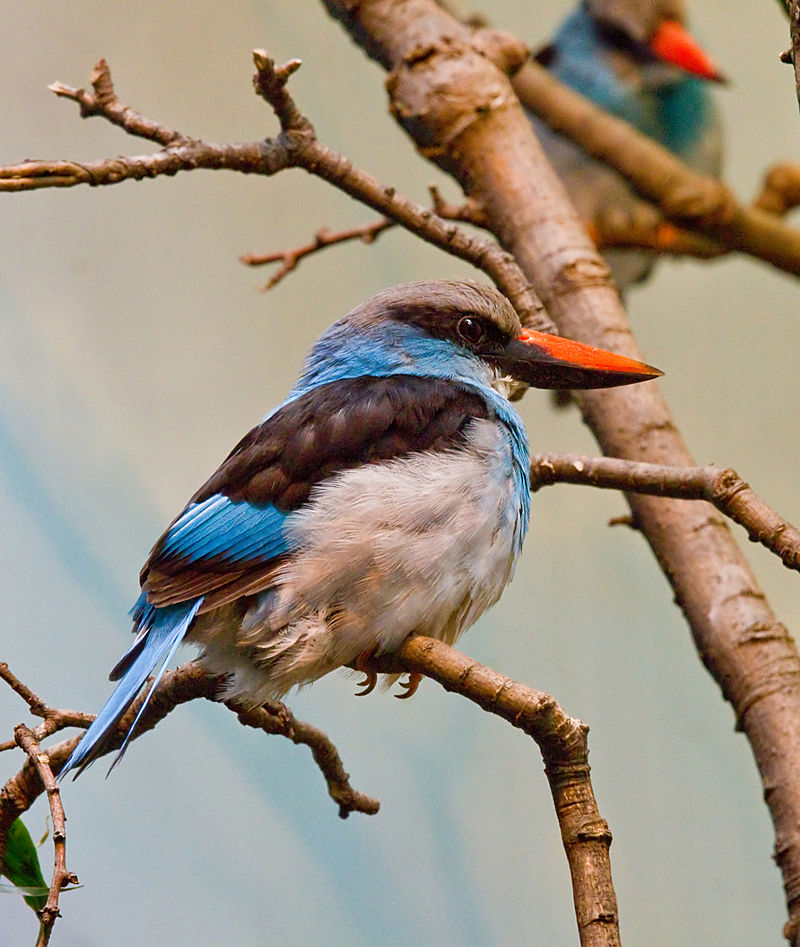
The Blue-breasted Kingfisher is a striking species of bird native to Equatorial Africa. Measuring 25 cm in length, this tree kingfisher has bright blue feathers on its head, back, wings and tail.
Its underparts are white with a contrasting blue breast band for added visual interest.
Though essentially resident there, it does migrate from drier savannas to wetter habitats during the dry season in order to survive better.
This species feeds mainly on insects such as beetles and grasshoppers but will also take small fish when available near the shorelines or riverside vegetation they inhabit.
The beautiful song of these birds can often be heard echoing through their natural environment – an unmistakable sound that makes them easily recognizable.
Scientific classification:
| Kingdom | Animalia |
| Phylum | Chordata |
| Class | Aves |
| Order | Coraciiformes |
| Family | Alcedinidae |
| Subfamily | Halcyoninae |
| Genus | Halcyon |
| Species | H. malimbica |
22. Forbes’s Plover
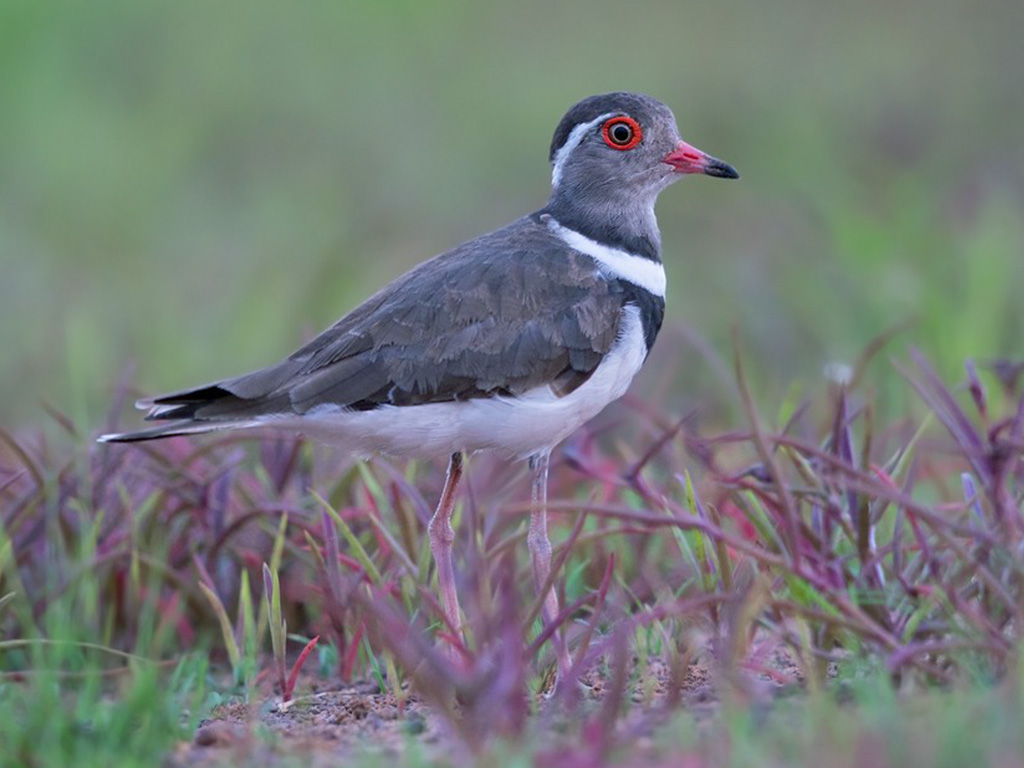
Forbes’s plover is a small wader native to West Africa, typically found in inland rivers and lakes. During the wet season they breed by making nests out of scrapes lined with pebbles on rocky uplands.
In the drier months they often move to open grasslands such as airfields or golf courses seeking food sources. They are also commonly seen at pools and reservoirs – usually hunting for insects, crustaceans or molluscs amongst shallow waters.
The Forbes’s Plover has been classified as near threatened due to its decreasing population numbers caused mainly by habitat destruction from human activities like urbanization and agriculture expansion.. However it still remains quite widespread in some parts of its range due to conservation efforts over recent years .
Scientific classification:
| Kingdom | Animalia |
| Phylum | Chordata |
| Class | Aves |
| Order | Charadriiformes |
| Family | Charadriidae |
| Genus | Charadrius |
| Species | C. forbesi |
23. Red-Billed Dwarf Hornbill
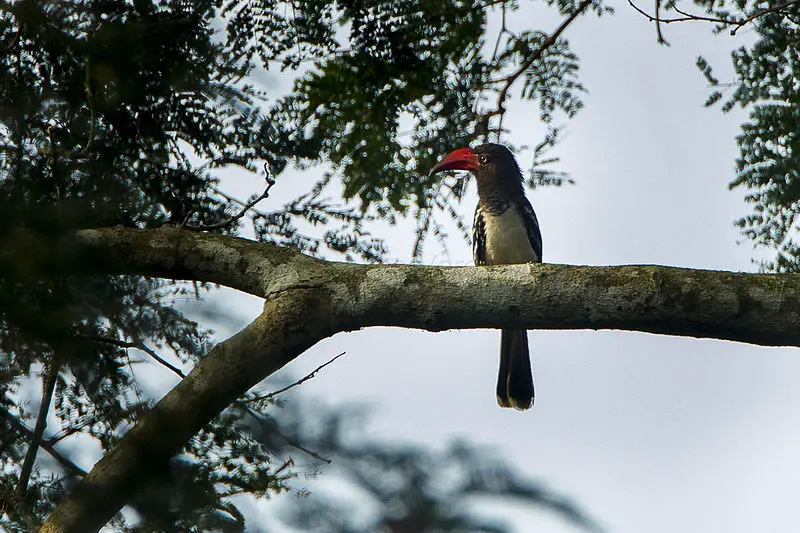
The red-billed dwarf hornbill is a species of bird found in the African tropical rainforest. It belongs to the Bucerotidae family and has a striking appearance, with its bright red bill contrasting against mainly black feathers.
Its wings are long and pointed, helping it to fly through dense vegetation quickly. The diet of this small hornbill consists mostly of insects, fruit and seeds.
They live both solitarily or in pairs but may form larger flocks during breeding season when they search for mates together.
These birds build their nests high up into tree hollows where they lay their eggs before taking turns incubating them until hatching occurs – an amazing example of teamwork.
Red-billed dwarf hornbills really are remarkable creatures that help keep natural ecosystems balanced throughout Africa’s lush forests; we should all do our part in protecting these majestic animals from extinction so future generations can appreciate them too.
Scientific classification:
| Kingdom | Animalia |
| Phylum | Chordata |
| Class | Aves |
| Order | Bucerotiformes |
| Family | Bucerotidae |
| Genus | Lophoceros |
| Species | L. camurus |
Also Featured In: Common Tropical Rainforest Birds,
24. Blue-Headed Coucal
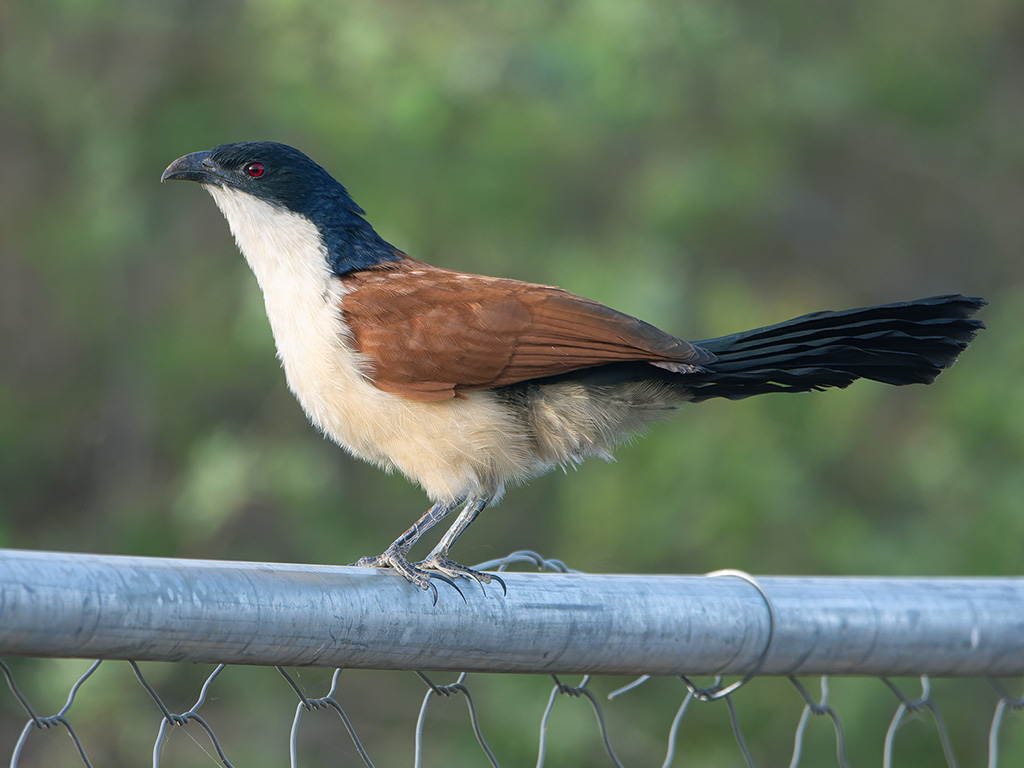
The Blue-headed coucal is a beautiful and unique species of cuckoo found in tropical central Africa. It inhabits areas near swamps, rivers, forests edges and other wet environments.
This bird is quite common with a large range which has led the IUCN to rate its conservation status as “least concern”.
Its distinguishing feature are its striking blue head feathers that it uses for courtship displays when searching for mates during breeding season.
The diet consists mainly of insects but can also include small reptiles or amphibians if available.
Despite their wide range they remain vulnerable due to changes in land use such as deforestation or agricultural development so careful monitoring must continue to ensure the survival of this charming species.
Scientific classification:
| Kingdom | Animalia |
| Phylum | Chordata |
| Class | Aves |
| Order | Cuculiformes |
| Family | Cuculidae |
| Genus | Centropus |
| Species | C. monachus |
25. Blue-Throated Roller
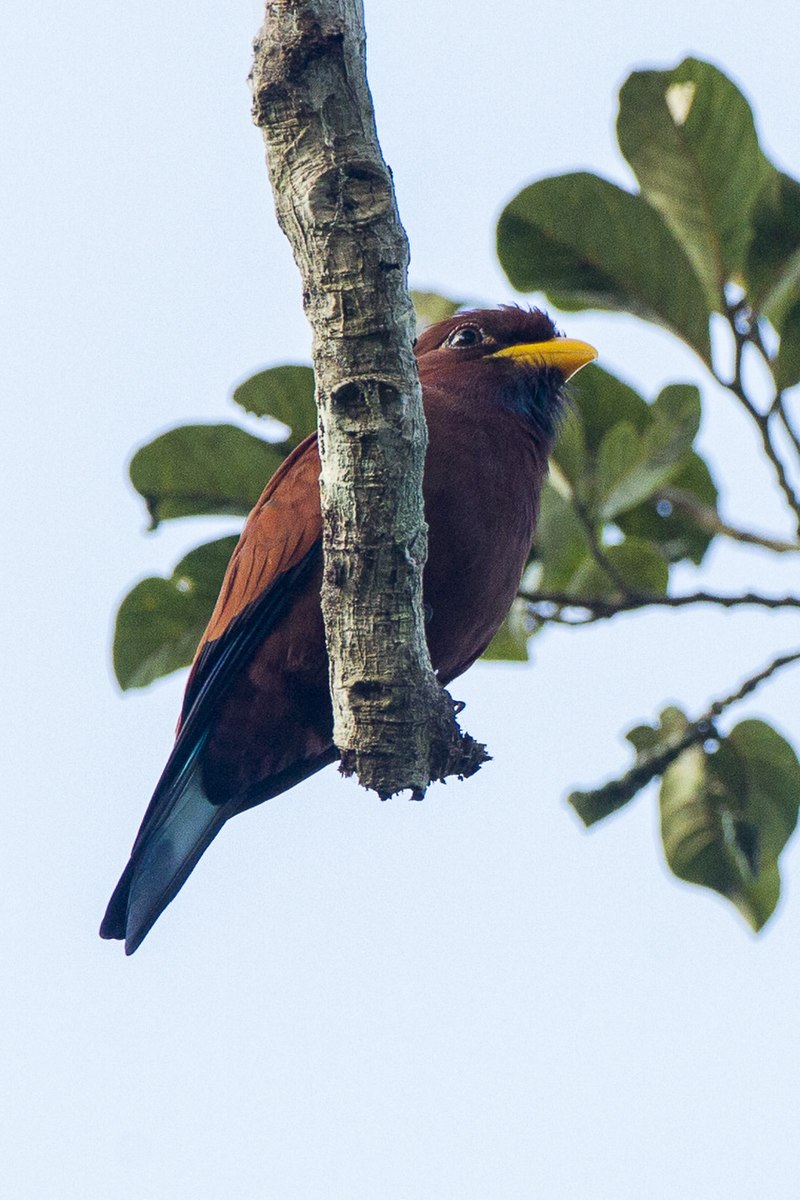
The blue-throated roller is an impressive bird native to the African tropical rainforests. It was formally described in 1819 by French ornithologist Louis Jean Pierre Vieillot, who gave it its current binomial name Eurystomus gularis – a Modern Latin word meaning “-throated”.
This species of roller belongs to the family Coraciidae and has striking plumage including metallic blue upperparts and chestnut or orange underparts with white spots. Its head is crowned with a glossy black crest which can be raised when alarmed or excited.
The blue-throated roller feeds mainly on insects such as grasshoppers, beetles, moths and cicadas but will also eat lizards, frogs, snails and small birds’ eggs.
During breeding season these beautiful birds perform spectacular aerial acrobatics for courtship displays that are sure to impress any observer.
Scientific classification:
| Kingdom | Animalia |
| Phylum | Chordata |
| Class | Aves |
| Order | Coraciiformes |
| Family | Coraciidae |
| Genus | Eurystomus |
| Species | E. gularis |
26. Chocolate-Backed Kingfisher
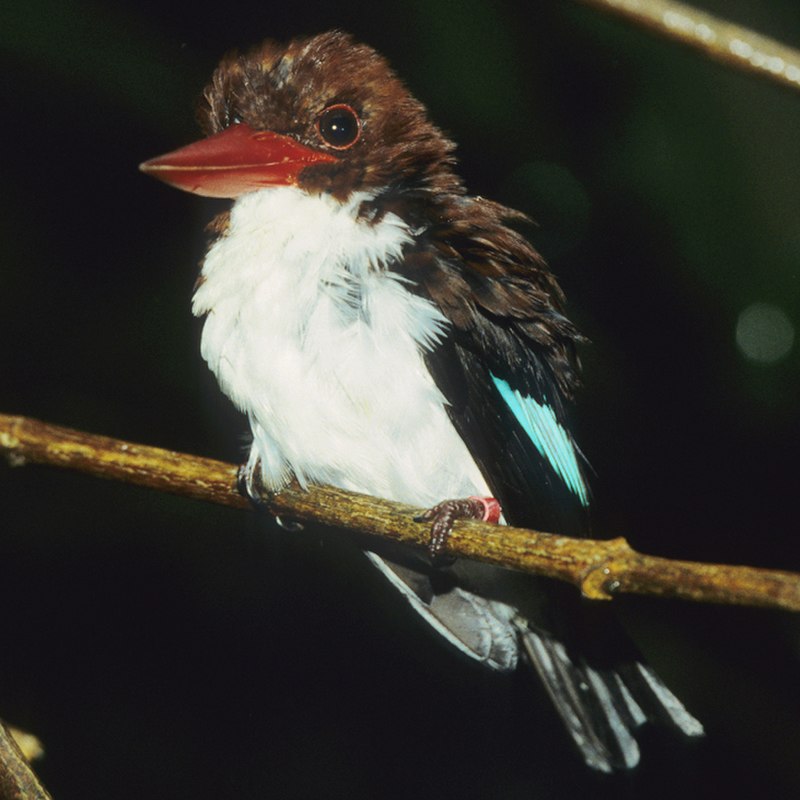
The Chocolate-backed Kingfisher is a beautiful sight to behold. It has dark upperparts and pure white underparts, as well as a black head and hind neck, brownish-black mantle, and brilliant iridescent blue rump.
This species of kingfisher can be found in western Sub-Saharan Africa where it usually inhabits open woodland or savanna habitats near water bodies like rivers or marshes.
They are solitary birds that feed on small fish they catch by diving into the water from an elevated perch.
These stunning birds also perform elaborate courtship displays consisting of aerial acrobatics while making loud calls to attract potential mates during breeding season.
Scientific classification:
| Kingdom | Animalia |
| Phylum | Chordata |
| Class | Aves |
| Order | Coraciiformes |
| Family | Alcedinidae |
| Subfamily | Halcyoninae |
| Genus | Halcyon |
| Species | H. badia |
27. Orange-Cheeked Waxbill
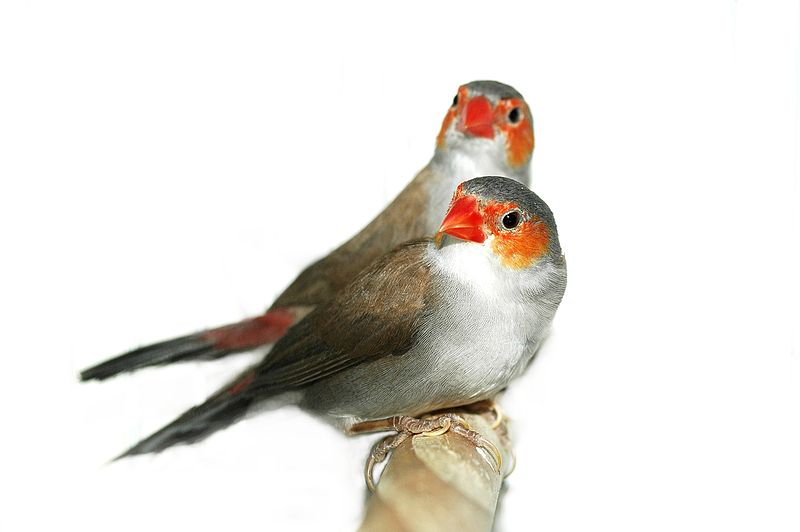
The Orange-cheeked Waxbill is a small finch native to western and central Africa. It has an orange cheek patch, giving it its name, as well as black stripes on the head and wings that stand out against its chestnut brown feathers.
This species lives in flocks of 30 or more individuals, which can be heard by their high pitched peeps echoing through the trees.
They are very acrobatic birds too – often seen flipping midair while chasing after tiny insects for food.
The global extent of occurrence for this species is estimated to be 3.6 million km2; making them quite common across their range within Africa.
Scientific classification:
| Kingdom | Animalia |
| Phylum | Chordata |
| Class | Aves |
| Order | Passeriformes |
| Family | Estrildidae |
| Genus | Estrilda |
| Species | E. melpoda |
Also Featured In: Martinique Island Birds You Should Know,
28. Yellow-Billed Turaco
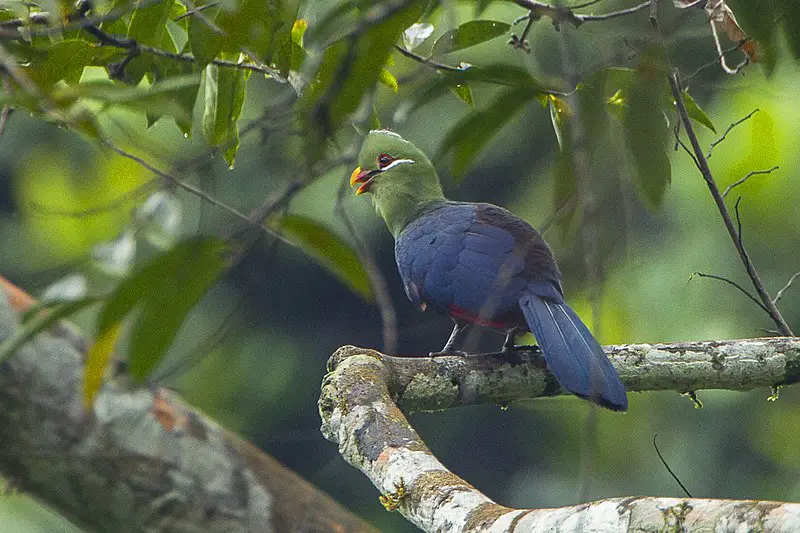
The Yellow-billed turaco is a species of bird found in West Africa, ranging from Angola to Sierra Leone. It has a striking yellow bill and bright red eyes that contrast with its mostly green plumage.
This beautiful bird usually lives in the canopy layer of tropical forests and woodlands, foraging for fruits or insects on the ground below. Unfortunately, their habitat is under threat due to deforestation caused by human activities such as logging and farming.
Additionally, they are hunted extensively throughout some parts of their range which further threatens this species’ survival. The discontinuity within their distribution range can be attributed mainly to drier climates within the Dahomey Gap region separating them into two populations – one near coastal regions and another more inland towards Central African countries like Cameroon & Gabon.
Scientific classification:
| Kingdom | Animalia |
| Phylum | Chordata |
| Class | Aves |
| Order | Musophagiformes |
| Family | Musophagidae |
| Genus | Tauraco |
| Species | T. macrorhynchus |
29. Bearded Barbet
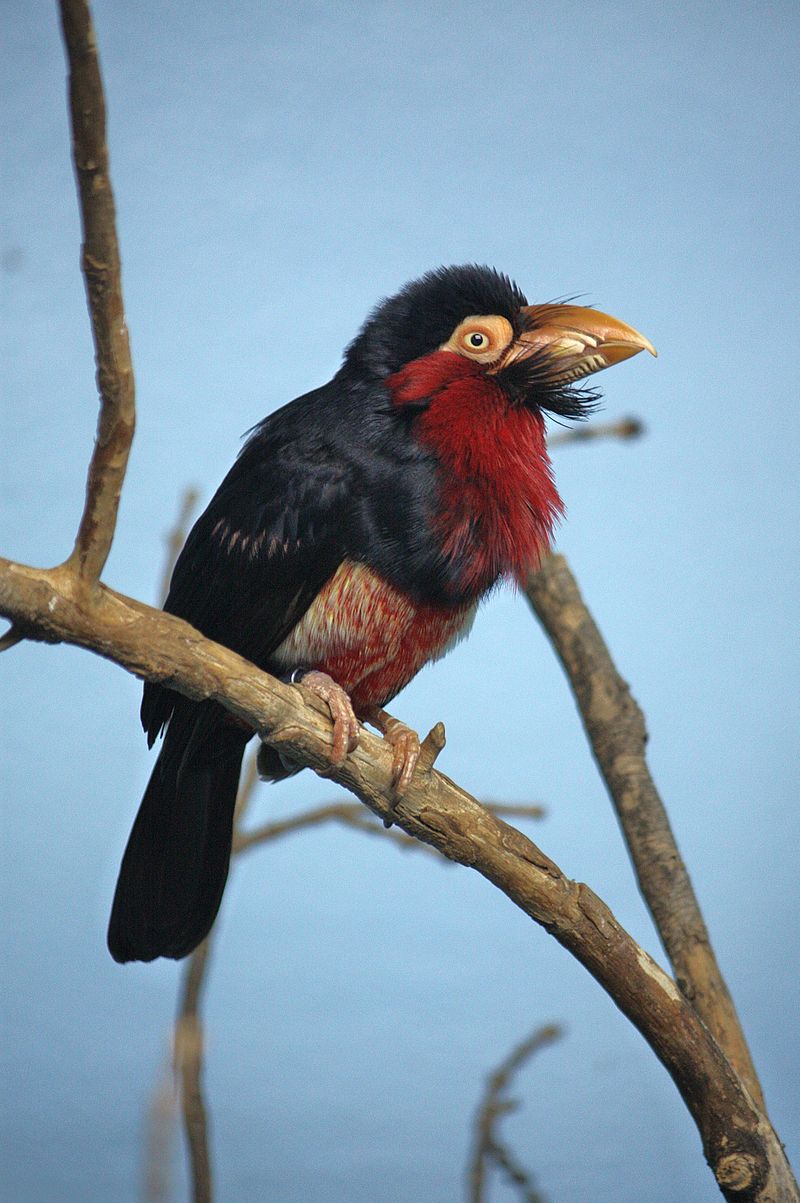
The Bearded Barbet is a passerine bird found throughout tropical parts of Africa. It can be identified by its bristly bill and colorful plumage, which ranges from grey to green depending on the species.
This barbet prefers wooded areas such as gardens or forests and feeds off fruits, nuts, insects, small reptiles and amphibians. The male has long yellow tufts around his eyes that give him a particularly striking appearance making it easy to distinguish between genders.
They are usually seen in pairs or small flocks but will sometimes congregate at feeding sites with other birds like parrots or pigeons for protection against predators.
These social creatures have an impressive repertoire of calls ranging from chirps to whistles which they use to communicate with one another while searching for food during the day time hours when they are most active.
Scientific classification:
| Kingdom | Animalia |
| Phylum | Chordata |
| Class | Aves |
| Order | Piciformes |
| Family | Lybiidae |
| Genus | Lybius |
| Species | L. dubius |
30. Yellow-Casqued Hornbill
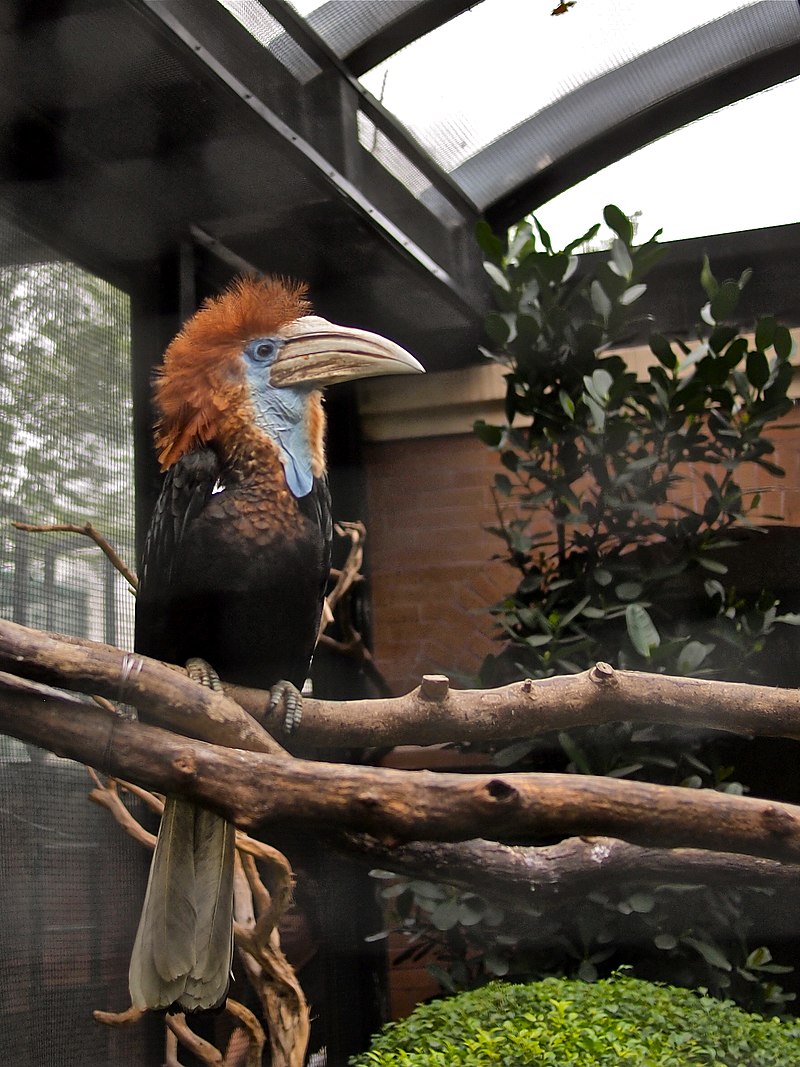
The Yellow-casqued Hornbill is an impressive bird found in the rainforests of West Africa. It has a bright yellow casque on its head and weight up to 2kg, making it one of the largest birds in its region.
Its primary habitat is in the canopy where they feed mostly on fruits, insects and small animals like lizards or frogs.
They are known for their loud calls which can be heard from far away during mating season when pairs join together to nest near tree hollows or cavities built by other species.
A monogamous pair stays together throughout breeding season with both parents taking turns incubating eggs and feeding chicks until they’re able to fly off into independence day.
These unique creatures have adapted well to their environment since ancient times, but due habitat destruction and human hunting activity threaten this species greatly today forcing conservationists across continents fight for their protection through policy change and public awareness campaigns.
Scientific classification:
| Kingdom | Animalia |
| Phylum | Chordata |
| Class | Aves |
| Order | Bucerotiformes |
| Family | Bucerotidae |
| Genus | Ceratogymna |
| Species | C. elata |
31. White-Spotted Flufftail
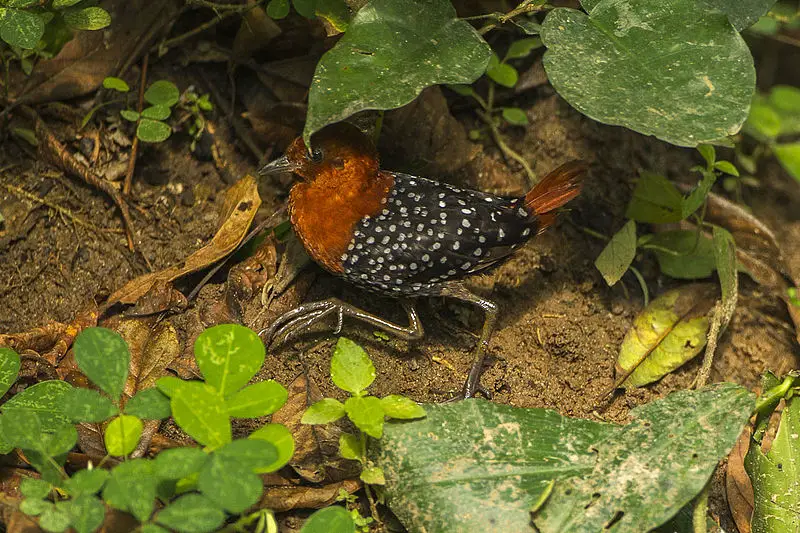
The white-spotted flufftail is a species of bird from the family Sarothruridae. It can be found in tropical rainforest regions across Africa, and its habitat consists of dense vegetation.
The colouration of this small bird is quite striking; it has a grey back, with reddish undertail coverts and black wings that are edged with white spots.
Its head features shades of brown and yellow, while its throat is notably creamy coloured.
These birds feed mainly on insects such as caterpillars but will also consume smaller amounts of fruit when available.
They build nests near water sources or under thick foliage to protect them from predators like hawks or crows which may attack their eggs or young chicks if they get too close by chance.
All in all, the white-spotted flufftail plays an important role in African ecology due to its insectivorous diet habits that help keep pest populations at bay.
Scientific classification:
| Kingdom | Animalia |
| Phylum | Chordata |
| Class | Aves |
| Order | Gruiformes |
| Family | Sarothruridae |
| Genus | Sarothrura |
| Species | S. pulchra |
32. Yellow-Throated Cuckoo
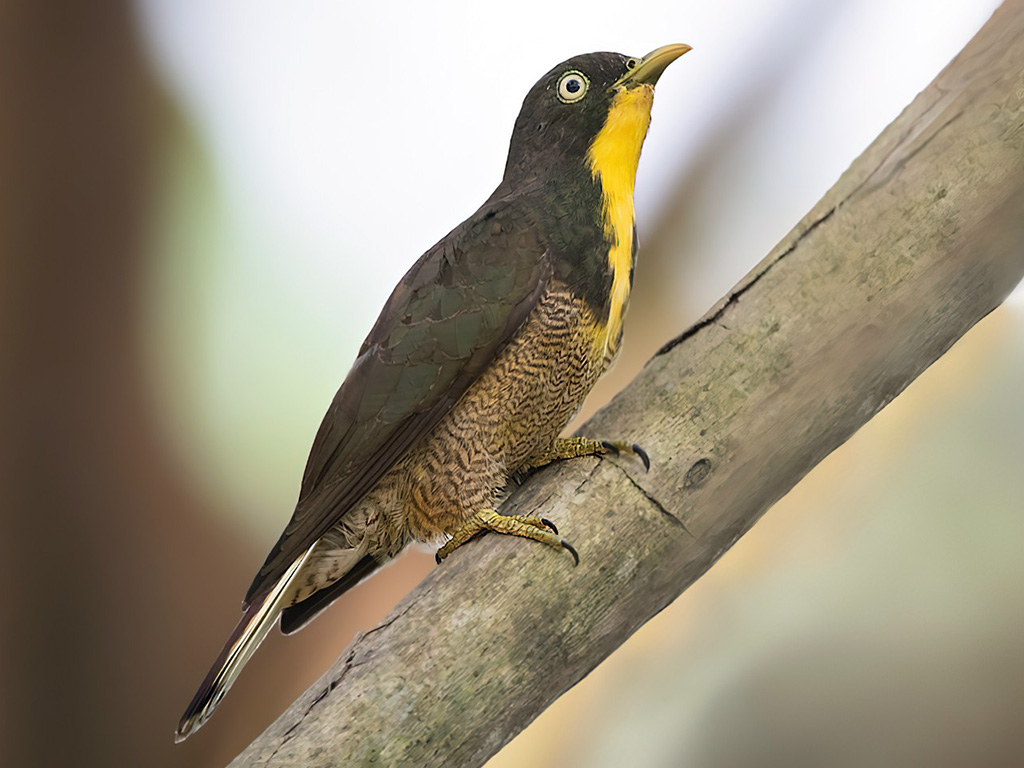
The Yellow-throated Cuckoo is a species of bird belonging to the family Cuculidae. It has an unmistakable yellow throat, contrasting with its grey-brown plumage, and bright red eyes.
The cuckoo inhabits tropical rainforest regions across Africa, where it can be found in dense foliage or perched on exposed branches near water sources such as rivers and streams.
Its diet consists mainly of insects including caterpillars, grasshoppers and beetles which are caught while flying through the forest canopy.
During breeding season males will sing loud melodic calls to attract a mate; both male and female participate in nest building which usually takes place high up within trees hollows or among vines for protection from predators.
The Yellow-throated Cuckoo is an important species for promoting biodiversity since it plays an essential role in controlling insect populations that could otherwise cause damage to crops if left unchecked.
Scientific classification:
| Kingdom | Animalia |
| Phylum | Chordata |
| Class | Aves |
| Order | Cuculiformes |
| Family | Cuculidae |
| Genus | Chrysococcyx |
| Species | C. flavigularis |